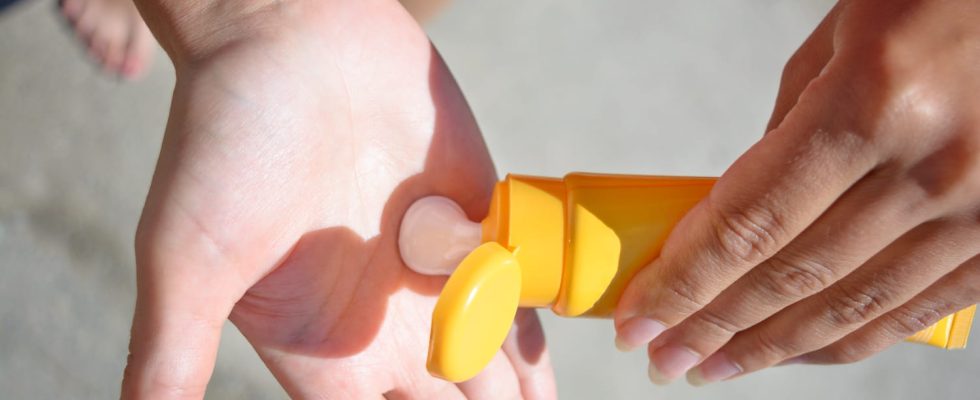Octocrylene is used in the composition of several sun creams sold in France. However, when the product ages, this sunscreen would degrade into a carcinogenic compound.
The National Health Security Agency (Anses) is asking the French government to restrict the use of octocrylene, A solar filter present in many sun creams (in particular certain products of the brands Garnier, Uriage, La Roche-Posay, L’Oreal…). In question, the risks of this chemical substance for the environment, specifies FranceInfo. The agency is also continuing its work on potential effects of endocrine disruptors octocrylene. A Franco-American study published in 2021 in the Journal of the American Chemical Society Chemical Research in Toxicology had shown that he could transform into a potentially carcinogenic compound for the man. Where is this substance present? What do we know about the risks of cancer? Explanations and products List which contain it.
Octocrylene is an organic compound (made of carbon compounds) used as a sunscreen in many cosmetics such as sunscreens, moisturizers, anti-aging, self-tanning creams… It is a viscous, oily and colorless liquid, which on the one hand makes it resistant to water, but also absorb UVB raysthe radiation responsible for the Sun tanningbut also skin aging, sunburnsburns, blisters and most skin cancer. This substance appears in the list of ingredients on the packaging sunscreen products marketed in France (often written in English “Octocrylen/Octocrylene”).
Octocrylene is present in many cosmetics including:
- Some sunscreens.
- Some anti-aging treatments.
- Some moisturizers.
- Some self-tanners.
- Certain shampoos.
Sunscreen brands: among products containing octocrylene analyzed by the researchers, there were:
- Garnier Ambre Solaire SPF 50,
- Bioderma Photoderm AR SPF 50+,
- Uriage Age Protect SPF 30,
- La Roche-Posay SPF 50,
- Cosmia Sun BB Cream SPF 50,
- L’Oreal Age Perfect SPF 20
- Coppertone Kids Sport SPF 50 Spray
- Banana Boat Clear UltraMist SPF 30 Spray
- Neutrogena Beach Defense SPF 100 Spray
→ See the list of products and the complete table of results In study available online.
Here are some sunscreen products that do not contain octocrylene (non-exhaustive list):
- Sunscreen dry touch SPF50+, Clarins
- Sunscreen SPF30, Polar Sun
- Face sunscreen SPF50, Caudalie
- Sublime sunscreen SPF30 Polysianes, Klorane
- Mineral face sunscreen, SPF30, Mate cucumber, Coola
- Face sunscreen SPF 30, Anthelios Ultra, La Roche-Posay.
The presence of octocrylene is must be mentioned in the ingredient list on the back of the bottle.
When the cosmetic product ages, octocrylene would transform and degrade within the bottles themselves in benzophenonea substance suspected of being a endocrine disruptor carcinogenicin addition to being very polluting for the environment, in particular for the coral. It is in any case the findings of the researchers of the Biodiversity and Microbial Biotechnology Laboratory of the Oceanological Observatory of Banyuls-sur-Mer (Sorbonne University/CNRS) and their American colleagues. Their work was published in the journal of the American Chemical Society Chemical Research in Toxicology. The team analyzed the composition and aging of 15 sunscreens and anti-aging treatments sold in France and in the United States, using a high performance mass spectrometer.
“Initially, there is very little benzophenone in the products. But gradually, as the product ages, there is more and more benzophenone (…) Of the benzophenone increases exceeding 100% and even reaching 200% have thus been observed“6 weeks after opening the product, Professor Philippe Lebaron, co-author of the study, told AFP. In other words, the concentration of benzophenone in the product would increase over time. This substance is all the more problematic in that it is easily absorbed by the skin. The World Health Organization’s International Agency for Research on Cancer has classified benzophenone as a “potentially carcinogenic to humans (Group 2B)“, recall the researchers. And to specify that, in animals, exposure to this molecule would induce liver cancer and lymphomasbut also dermatological problems. According to the scientists, the safety of octocrylene in cosmetic products should, following the publication of this study, be quickly reviewed by regulatory bodies.
The study researchers advise against the use of products containing octocrylene. To find out if your product contains it, check its label. The presence of octocrylene is must be mentioned in the list of ingredients on the back of the bottle or product packaging.
Sources: A filter present in many sunscreens turns into a carcinogenic compound, CNRS, March 8, 2021 / Study Benzophenone Accumulates over Time from the Degradation of Octocrylene in Commercial Sunscreen Products, ACS Publications.
